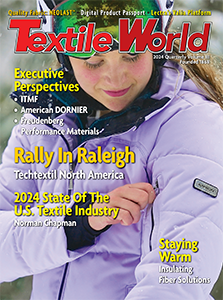BUSTO ARSIZIO, Italy/MUNICH, Germany — February 7, 2020 — The standard system in the industry is currently based on a sock-shaped waterproof lining — also known as a “bootie” — which is completely separated from the external shoe layer, the upper, leaving room for water to penetrate the shoe. As a result, the shoe may soak up water, making it damp, heavy and cold. To compensate for this lack, conventional shoe upper materials are heavily impregnated with unhealthy perfluorinated chemical compounds (PFCs).
HDry technology introduces a completely new waterproofing method by the ‘one-step’ direct 3D lamination of the waterproof and breathable membrane onto the upper inner side: The direct fusion of upper shoe material with the waterproof membrane effectively stops the water right at the outside of the shoe, before it can penetrate the inside layer. As a result, the shoe offers an extremely dry and warm overall performance, while altogether eliminating the possibility of moisture build-up between the outer layer and membrane. And with no or very limited use of DWR treatment on the upper material.
In a nutshell, by a more efficient use of less material, the waterproof function is greatly enhanced.
Materials
HDry compound is made by a polyurethane ester-based waterproof/breathable membrane combined with thin polyester knit. Material saving and lightness are the greatest advantages. HDry is absolutely PTFE-free and no perflourinated compounds (PFCs, PFOS, PFOA etc.) are used on its production. HDry does not contain any substance of the REACH – ECHA list.
Design – more freedom and desireability
With HDry, lining is completely independent and separated from the membrane, and it can be made by any suitable materials (leather, textile etc.). This dramatically facilitates the use of Sustainable and recyclable lining.
Production – owed to sustainability and durability
HDry lamination process is realized by hot melt glue. There is therefore no need for the use of a solvent glue base which are widely used in standard ‘bootie’ process to keep it in correct position and also in the attempt to limit the water penetration through the upper material and the seams. Seam sealing taping of the lining membrane is also eliminated and replaced, in the HDry system by a thin membrane welding by high frequency. Moreover, having the membrane directly laminated to the upper back instead of to the lining, the shoe volume is reduced (it is usually possible to wear an 1⁄2 size less than with a conventional bootie system): this means up to 5% saving on materials (textile, leather, rubber, glue etc.) in footwear manufacturing.
Product Lifetime – to reduce the environmental footprint of waterproof footwear
In shoes made with the bootie construction, the largest part of shoe components (toe puff, reinforcements, insole, etc.) keep in between the upper and the lining membrane and therefore get soaked in rain conditions. Conversely, inside shoes made with HDry technology, these components remain on the dry side of the HDry membrane. As result, shoe is no longer getting soaked and damp without hydrolysis effects on its components: the product lifetime is greatly enhanced, which is actually the most effective way to reduce footwear environmental footprint.
Posted February 7, 2020
Source: GREENSIDE




